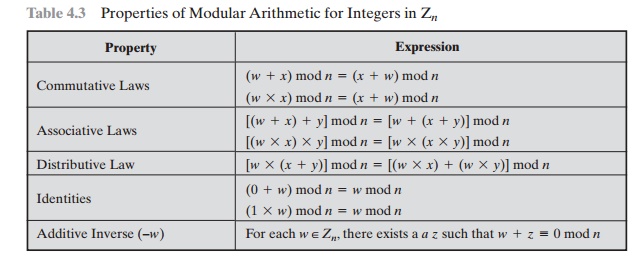Topics
Modular Arithmetic, Euclidean and Extended Euclidean algorithm, Prime numbers, Fermat and Euler’s Theorem
Modular Arithmetic
- Computation of “mod” or “modulus” or “%” operation of expressions.
- Which is defined as the remainder after dividing one number by another.
a mod b = c, c is the remainder- Example: 10 mod 9 equals 1. Because 1 is remainder after dividing 9 by 10.
Operations
Modular Addition, Subtraction, Multiplication, Exponentiation
(a + b) mod m = ((a mod m) + (b mod m)) mod m
(a - b) mod m = ((a mod m) - (b mod m)) mod m
(a x b) mod m = ((a mod m) x (b mod m)) mod m
(a ^ b) mod m = ((a mod m) x (a mod m) ... b times) mod m
Quotient Remainder
States that for any pair of integers a and b (b is positive), there exists two unique integers q and r such that:
a = b x q + r
where 0 <= r < b
Modular Inverse
if (a x b) mod m = 1 then b is the modular inverse of a.
Given that a, m are prime i.e gcd(a,m) = 1 and 'a' in range {1, 2, 3 ... m-1}
Example : (4*3) mod 11 = 1
Modular Division
It doesn’t always exist.
(a / b) mod m is not equal to ((a mod m) / (b mod m)) mod m.
(a / b) mod m = (a x (inverse of b if exists)) mod m
Congruent
a, b and m are integers with m > 0
a ≡ b (mod m); remainder of a/m
a = mk + b
a mod m = b mod m
Properties
(Write as it is in Addition, Multiplication in Commutative, Associative, Distributive) mod m
Identities for ➕(0) , ✖️(1)
Inverse makes remainder 0

Euclidean Algorithm
Basic
GCD – Greatest Common Divisor = HCF - Highest Common Factor
LCM – Least Common Multiple
List all factors always.

- If we subtract a smaller number from a larger one (we reduce a larger number), GCD doesn’t change. So if we keep subtracting repeatedly the larger of the two, we end up with GCD.
- Now instead of subtraction, if we divide the smaller number, the algorithm stops when we find the remainder 0.
gcd(a,b) = gcd(b, a mod b)
gcd(a, 0) = a
Extended
Make table and try it here Watch this
Table - Basic + 120, 1001
s = s1 - q.s2
t = t1 - q.t2
s1 & t1 of last becomes s, t
s*a + t*b = gcd(a,b)
Prime numbers
Prime Number : Whole numbers greater than 1 that are only divisible/have factors 1 and itself.
Semi-Prime : Numbers whose factors are only prime numbers, excluding 1 and the number itself.
🔥 Product of two primes are always semi-prime.
Example : 21 - 1, 3, 7, 21, here 7 and 3
Relatively/Co-Prime/Mutual Primes : When only common factor is 1. GCD(a, b) = 1 | LCM(a, b) = a × b
- It doesn’t matter if a, b is either or both are composite or prime.
- Example: 4, 15.
Euler’s Theorem
Euler’s Totient Function
Number (Count) of positive integers less than ‘n’ that are relatively prime to ‘n’
φ(n)
- If ‘n’ is prime, then φ(n) = n-1
- If ‘n’ = p × q is product of primes(these are numbers are called semi-prime), then φ(n) = (p-1) x (q-1).
- Else φ(n) = n x ( 1 - 1/p1) x ( 1 - 1/p2), p1, p2 … are distinct prime factors of n.

Euler Theorem
- E for Euler and E for Exponent, hence Exponent Totient.
- For any two positive integer ‘a’ & ‘n’, which are relatively prime.
- Example a = 3, n = 10

Fermat’s Theorem
- If ‘p’ is a prime number and ‘a’ is a positive integer not divisible by ‘p’ OR ‘a’ not a multiple of P.
- Example a = 2, p = 5
👁️ Structure is same, p & n differs.
Comments
Post a Comment